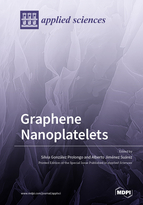Graphene Nanoplatelets
A special issue of Applied Sciences (ISSN 2076-3417). This special issue belongs to the section "Nanotechnology and Applied Nanosciences".
Deadline for manuscript submissions: closed (31 October 2019) | Viewed by 51333
Special Issue Editors
Interests: polymers; composites; recyclable; sustainable; smart polymers
Special Issues, Collections and Topics in MDPI journals
Interests: multifunctional composite materials; self-healing materials; 3D printed nanocomposites; structural health monitoring
Special Issues, Collections and Topics in MDPI journals
Special Issue Information
Dear Colleagues,
The interest in carbon nanostructures has been increasing continuously for decades, and among them, graphene nanoplatelets (GNPs) have attracted the interest of many researchers as a possible innovative solution to many industrial challenges, such as solar cells, thermal interface materials, or catalysts, among others. Nevertheless, the availability and uniformity of GNPs properties is still a challenge to overcome in order to scale up their use to an industrial level.
GNPs consist of individual layers of graphene, which are constituted by a single atomic layer of sp2 carbon atoms which are arranged forming a hexagonal structure commonly known as a honeycomb structure. The unique properties of GNPs strongly depend on their morphology and chemical characteristics, thus making their customized modification to fulfill each of their possible applications an exciting challenge. Therefore, important efforts are currently being applied to modify manufacturing processes to obtain GNPs with particular characteristics such as functional groups that could help during their later use to obtain final products.
The Special Issue of the journal of Applied Sciences titled "Graphene Nanoplatelets" aims to cover the most recent and outstanding research activities related to these nanoparticles regarding their production and modification process, their study to prove any of their interesting properties or their final applications. Their use in fields such as (but not limited to): reinforcement in nanocomposites, multifunctional composites with thermally and electrically improved properties, structural health monitoring (SHM), thermal interface materials (TIMs), catalysts, solar cells, or supercapacitors could be potential topics for this issue.
This Special Issue also publishes the selected papers from 12th International Conference on Advanced Computational Engineering and Experimenting, ACE-X 2018, Amsterdam, the Netherlands, 1-5 July 2018.
Guest Editors
Manuscript Submission Information
Manuscripts should be submitted online at www.mdpi.com by registering and logging in to this website. Once you are registered, click here to go to the submission form. Manuscripts can be submitted until the deadline. All submissions that pass pre-check are peer-reviewed. Accepted papers will be published continuously in the journal (as soon as accepted) and will be listed together on the special issue website. Research articles, review articles as well as short communications are invited. For planned papers, a title and short abstract (about 100 words) can be sent to the Editorial Office for announcement on this website.
Submitted manuscripts should not have been published previously, nor be under consideration for publication elsewhere (except conference proceedings papers). All manuscripts are thoroughly refereed through a single-blind peer-review process. A guide for authors and other relevant information for submission of manuscripts is available on the Instructions for Authors page. Applied Sciences is an international peer-reviewed open access semimonthly journal published by MDPI.
Please visit the Instructions for Authors page before submitting a manuscript. The Article Processing Charge (APC) for publication in this open access journal is 2400 CHF (Swiss Francs). Submitted papers should be well formatted and use good English. Authors may use MDPI's English editing service prior to publication or during author revisions.
Keywords
-
graphene
-
graphene oxide
-
nanosheet
-
nanoplatelet
-
nanofiller
-
nanomaterial
-
nanocomposite
-
smart material
-
multifunctional material
-
multiscale material







